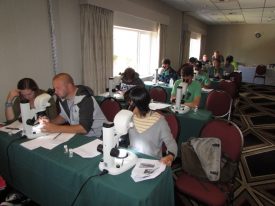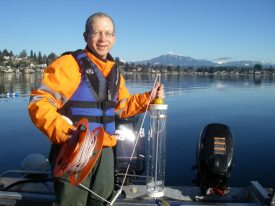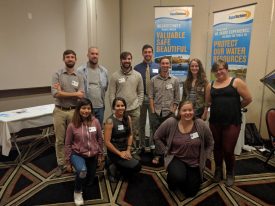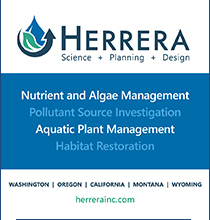WALPA headed north to Bellingham in October to host its 29th annual conference at the Four Points Sheraton. This year’s theme was “Lakes – Reflections of Change.” More than 90 members — lake managers, professionals, students and lakeside residents — attended to share their lake management knowledge and network with others from around the state.
The conference started with an afternoon of workshops on macroinvertebrate and phytoplankton identification, for which participants could receive continuing education credits. Jim Helfield and Joan Vandersypen from Western Washington University (WWU) provided attendees a hands-on lesson on macroinvertebrate identification. Robin Mathews, also from WWU, gave a glimpse into the fascinating world of phytoplankton identification, focusing on cyanobacteria.
Dr. Michael Brett, a professor from the University of Washington, kicked off the conference’s first full day with a thought-provoking plenary talk on “How do we balance the (possibly) conflicting goals of phosphorus removal, ecosystem services and sustainability in the Spokane River Basin?” Dr. Brett’s talk sparked meaningful discussions throughout the conference. After the plenary, participants heard great presentations about lake monitoring, lake management, outreach and education, problem bacteria and invasive species, current student research, and a special focus on nearby Lake Whatcom. With many excellent speakers, the conference once again proved to be a perfect forum for learning about the variety of lake research and management issues across the state.
During the lunch business meeting, WALPA board members gave updates on the progress made in public policy, by-laws, membership and scholarship committees, as well as efforts to establish a state volunteer monitoring program. The group congratulated WALPA’s 2016 scholarship winners: Vincent Jobin from the University of Washington, Zach Klein from the University of Idaho and Randi Bowman from Lewis-Clark State College. Changes in the WALPA board were announced for the coming year. Rachael Gravon was chosen as President-Elect, Jim Gawel will step in as President, and Jen Oden was elected Treasurer. Past President Ellen Preece and outgoing board member Susanne Martin were recognized and thanked, and incoming board members Jenifer Parsons and Lizbeth Seebacher were introduced.
Gene Williams was presented with the 2016 Secchi Disk Award for his outstanding work in lake management and protection. Gene, recently retired, has spent the last 28 years creating a diverse and innovative lake management program in Snohomish County, working on water quality monitoring, outreach, lake restoration and invasive aquatic plant control. He is also the longest-serving board member in WALPA’s history, collectively volunteering over 10 years on the WALPA Board.
The social hour Wednesday night was a great place for informal discussion, student posters and our fourth annual raffle and silent auction, made possible by donations from more than 20 businesses! The silent auction and raffle were followed by an exciting live auction for an InSitu SmarTroll, a YSI ProDSS, and a Hach Hydrolab HL4. In all, the event raised more than $10,000 to support WALPA’s mission and fund student scholarships.
Students from across the region had a big presence at this year’s conference throughout the talk and poster sessions and won prizes for their work:
- Best undergrad poster – Kellen Maloney (UW Bothell) Investigating the ability of substrates inoculated with mushroom mycelium to reduce fecal coliform bacteria contamination in surface water
- Best graduate student poster – Tim Taylor (WSU) Evaluating the precision of lake-dwelling brook trout age structures
- Best undergrad presentation – Anthony Endresen (UW Tacoma) Phytoremediation of arsenic by aquatic plants in contaminated urban lakes in the South-Central Puget Sound Region
- Best graduate presentations (tied) – Andrew Child (WSU) From farm to table: tracking availability and bioaccumulation of heavy metals in freshwater zooplankton in northeastern Washington lakes and Vincent Jobin (UW) Landscape position defines lake water level fluctuations in response to past climate in the Pacific Northwest
The conference concluded with a field trip to Lake Whatcom led by staff from the City of Bellingham and Whatcom County. The field trip showcased a variety of programs working together on lake protection in the Lake Whatcom watershed.
Thank you to everyone for attending, as well as to the presenters, sponsors and all the WALPA Board who helped make this event a great success. If you couldn’t make it, read on to see what you missed and be sure to check out www.walpa.org for a list of the session abstracts













